 Lourdes, France
Lourdes, France
As an orator, Pope Benedict XVI generally does not, unlike his predecessor John Paul II, mine his own biography. For John Paul, the dramatic events of his life were staples of his public rhetoric. Not so with Benedict, who prefers to emphasize the song rather than the singer.
It was therefore particularly striking that one could hear faint echoes of Joseph Ratzinger’s past in his final address at Lourdes this morning, which came in an open-air Mass on a chilly morning outside the Basilica of Our Lady of the Rosary. The Mass was dedicated to the sick and disabled who flock to Lourdes, and many in the crowd arrived in wheelchairs or on crutches.
When the pope said that seeking the loving smile of the Blessed Virgin Mary “is not an act of devotional or outmoded sentimentality,” that it is not “pious infantilism,” he was not merely addressing attitudes he knows to be widespread in post-Vatican II Catholicism. He was also indirectly opening a window onto his own spiritual journey – because these are indictments of Marian piety to which the pope himself was once tempted.
In that light, it’s an interesting exercise to discern where Benedict has come from with regard to Mary, and more importantly, where he has arrived.
In an interview in 2000, then-Cardinal Joseph Ratzinger recalled that as a young priest and theologian, he was suspicious of Marian devotion. Influenced by the great liturgical pioneers of the early 20th century, especially Romano Guardini, he worried that para-liturgical phenomena such as Marian devotions amounted to distractions from the centrality of Christ. Moreover, coming of age in post-war Germany, the young Ratzinger was enormously sensitive to the ecumenical dimension of Christian life, and he knew that many Protestants find the Catholic emphasis on Mary unbiblical and, frankly, a flirtation with paganism.
When Ratzinger wrote his 1964 commentary on the second session of Vatican II, his most caustic language came in lampooning proposals from some pious bishops to assign Mary new dogmatic titles, such as “Co-Redemptrix,” or to consecrate the entire world to Mary. Such ideas, the young Ratzinger wrote, did not say much about the “theological enlightenment” of the prelates who floated them.
In the four decades since, Benedict XVI has covered a great deal of ground. Today he feels deep affection for Mary, which he made clear this morning.
Falling in love with Mary, Benedict said, is the aspiration of “those who have attained the highest degree of spiritual maturity, and know precisely how to acknowledge their weakness and poverty before God.”
Perhaps the most telling line from this prodigious academic, for whom the written and spoken word is all-important, was the following: “When speech can no longer find the right words, the need arises for a loving presence. We seek then the closeness not only of those who share the same blood or are linked to us by friendship, but the closeness of those who are intimately bound to us by faith. Who would be more intimate to us than Christ and his holy Mother, the Immaculate One?”
One might say this “discovery” of Mary reflects Benedict’s pastoral side, his growing realization that people need to be comforted, not just catechized. It also reflects a conviction, forged in ecclesiastical battles over the years, that what Benedict once called “simple believers” often have a keener sense of the faith than erudite theological experts.
Yet Benedict XVI remains a man of reason, so even in his most tender moments of longing for Mary’s maternal smile, his critical faculties never quite go off-line. While he has moved closer to popular devotion, it is nonetheless a “purified” devotion, one in which the thaumaturgical dimension is deliberately soft-pedaled.
Lourdes attracts six million pilgrims annually for a variety of reasons, but the reputed wonder-working power of its springs is an enormous part of the appeal. While the church has officially recognized only 66 miracles at Lourdes (the most recent occurred in 1987), officials have discretely adopted the language of “phenomenal events” to refer to the thousands of reports of cures that pour in each year.
It’s noteworthy, therefore, that Benedict repeatedly, though gently, insisted in Lourdes that miracles are not the heart of the matter. Speaking on Saturday, the pope indirectly cautioned against overheated expectations of divine intervention.
“How many come here to see it with the hope – secretly perhaps – of receiving some miracle,” the pope said. “Then, on the return journey, having had a spiritual experience of life in the church, they change their outlook upon God, upon others and upon themselves.”
Today, shortly before he administered the sacrament of the Anointing of the Sick, the pope returned to the point.
First, he argued that the real significance of the waters that Mary revealed to Bernadette 150 years ago is metaphorical.
“From [Mary’s] womb, rivers of living water have poured forth to irrigate human history,” the pope said. “The spring that Mary pointed out to Bernadette here in Lourdes is the humble sign of this spiritual reality.”
Later, Benedict reflected on what it means to regard Christ as a “healer.”
 t“Christ is not a healer in the manner of the world,” the pope said – meaning that physical cure is not the point.
t“Christ is not a healer in the manner of the world,” the pope said – meaning that physical cure is not the point.
“In order to heal us, he does not remain outside the suffering that is experienced,” the pope said. “He eases it by coming to dwell with the one stricken by illness, to bear it and to live with him. Christ’s presence comes to break the isolation which pain induces. Man no longer bears his burden alone. As a suffering member of Christ, he is conformed to Christ in his self-offering to the father.”
Benedict encouraged the sick and disabled to “turn to Mary,” not in the sense of seeking immediate cure, but rather for “the strength to fight against sickness in support of life,” as well as “the grace to accept without fear or bitterness to leave this world at the hour chosen by God.”
None of this means that Benedict scorns a prayerful hope for physical signs, but it is clearly not where he places the accent.
That caution is reflected in news out of Rome today, for example, that the Congregation for the Doctrine of the Faith is drawing up new, and reportedly more stringent, guidelines for the approval of alleged apparitions. (In part, the move is a response to the sensation touched off in Italy when Bishop Girolamo Grillo of Civitavecchia, the port north of Rome, seemed to endorse reports that a statue of the Madonna owned by a local family had wept tears of blood.) It’s also evident in the policy of the CDF, adopted during Ratzinger’s years as prefect, of maintaining a discrete silence about the reported apparitions in Medjugorje.
John Paul II was arguably a bit more inclined to see the wondrous. Famously, he believed that the Virgin changed the flight path of a bullet on May 13, 1981, when Mehmet Ali Agca fired at him from close range in St. Peter’s Square. That day happened to be the feast of Our Lady of Fatima, and John Paul would later travel to Fatima to place the bullet doctors removed from his body before the statue of the Virgin to thank her for her intervention.
Despite the deepest possible respect for John Paul, Benedict might well be more hesitant to read cosmic significance into the vicissitudes of his own life.
To sum all this up in a sound-bite: In contrast to both cold skepticism and hot devotion, Benedict XVI embodies what one might call “Marian cool.” Neither cynical nor credulous, he harbors deep feeling for Mary and a keen sense of her theological importance, combined with reserve about the signs and wonders that surround eruptions of new Marian enthusiasm.
Whether “Marian cool” will sweep the Catholic world remains to be seen, but it may well be the most original feature of Benedict’s two and a half days in Lourdes.
---------------------------------------------------------------------
John Allen is filing stories throughout the pope's visit to France and Lourdes. Read all the stories in his daily news column: John L Allen Jr Daily Column. Stories he has already filed include:
Sept 14
• Pope offers prayerful meditation on Eucharist: Jesus 'past, present and future'
• Pope in France: Traditionalists deserve 'a place in the church'
• The Cross, Mary, and hope for 'new vigor' in the Church
Sept 13
• Pope tells shrunken church, 'Don't be afraid'
• Lourdes: Nothing says 'Catholic' like the Virgin Mary
• Explaining Benedict's discretion on Islam
Sept 12
• No reference to Muslims, but pope makes a call to resist 'disaster for humanity'
• Benedict makes a case for 'healthy secularism'
• Pope in France: Averting a secular Iron Curtain
• Pope in France: Latin Mass an 'act of tolerance'
Earlier stories
• Extracts from Sarkozy on church/state relations in France
• Cardinal Tauran on the pope's trip to France
• The Marian Papacy of Benedict XVI
• Benedict hopes to tap the 'creative minority' of French Catholics
(Editor's Note: Some stories are double posted, on NCRonline.org and on NCRcafe.org.)
---------------------------------------------------------------------




